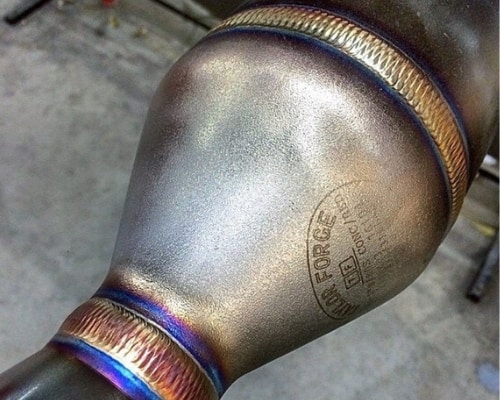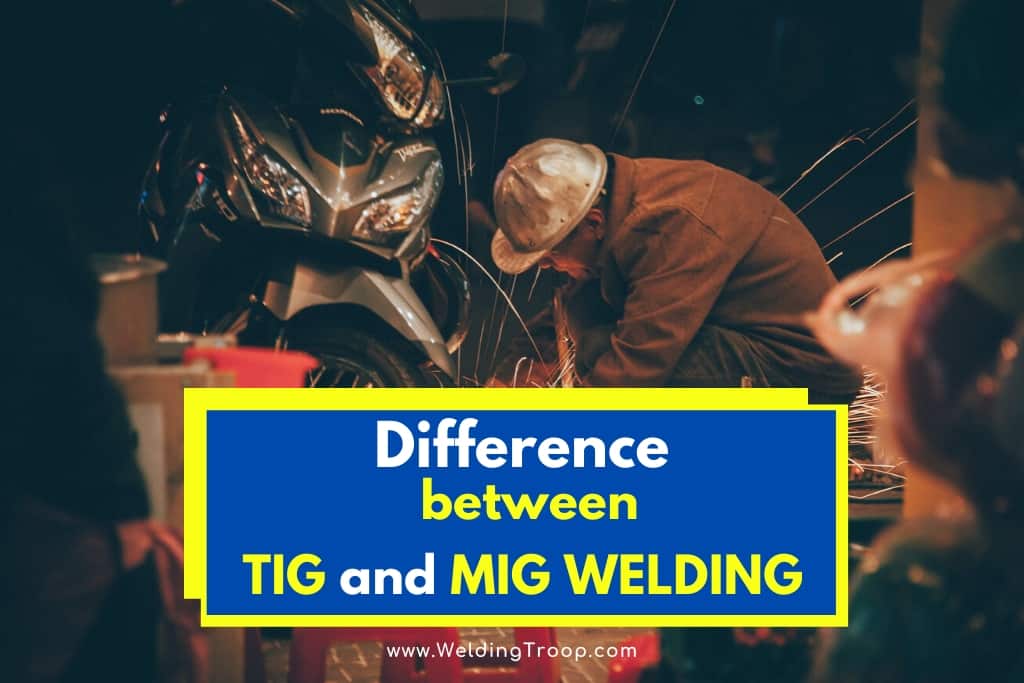Although learning to weld is daunting at first, learning the difference between a few welding processes is a great place to start. Once you know a bit about the different welding processes, you’ll be able to visualize how they impact your project.
What’s the difference between TIG and MIG welding? The difference between TIG (tungsten inert gas) and MIG (metal inert gas) welding is that TIG welding uses a tungsten metal rod to fuse two metals directly together, while MIG welding uses a feed wire through a spool gun to weld two metals together.
You’ll need to know a bit more about how these processes work and what their strengths and weaknesses are before deciding which one is right for the kind of weld you want to produce.
Table of Contents
The Difference Between TIG and MIG Welding
While there are many other kinds of welding, TIG welding, and MIG welding are two of the most common processes. While inexperienced users are better off learning MIG welding first, understanding how TIG welding is used can help beginners explore how different forms of welding can change future projects.
The Process
While MIG welding uses a consumable filler wire or a wire that melts down into part of the weld itself during the process, TIG welding uses a tungsten rod, which is non-consumable and acts as an electrode to produce a small arc that creates the weld pool without always needing to add filler material.
- MIG welding is far faster to learn because it regulates some variables in your weld. It uses a spool gun to feed filler wire into the weld at the rate you set. You can also set the heat the arc is producing, which is referred to as the “amp,” to one temperature when using MIG welding.
- TIG welding uses a non-consumable tungsten rod to create a weld pool. You must use a foot pedal to control the heat of the arc. To add filler when using this type of welding, you need to feed the wire into the weld pool by hand. This requires much more coordination than a MIG weld.
Shielding Gases
Shielding gases protect the electrode from outside gasses that can cause the melting pool to oxidize, resulting in a weaker weld. They can also make a difference in the fume generation rates of your weld as well as spatter control.
TIG welding always uses 100% argon as its shielding gas composition, whereas MIG welding can use a blend composition of carbon dioxide, helium, and argon (Lincoln Electric). Gasless MIG welding, also called flux core welding (FCAW), uses flux material, a mix of carbon and silicate, for a result similar to that of a gas MIG weld.
Overall Ease of Use
While TIG welding gives you more control and precision in your weld, MIG welding is much easier and faster to perform. Understanding the pros and cons of each process can make it easier to figure out which one is best for your next welding job.
How to Choose Which Welding Process to Use: MIG vs TIG >> Tutorial video
Why MIG Welding is Better for Inexperienced Welders
If you’re new to the welding game, MIG welding will probably be your best friend. People prefer MIG welding when they need a process that is straightforward, fast, and relatively cheap.
It’s known as the hot glue gun of welding for a reason. Here’s a bit more on what the tool does that makes a beginner’s life easier:
- Because the MIG welder creates a larger, hotter arc, it can weld base materials together even if there is some debris on them. The TIG weld will not be able to get hot enough to weld through anything but perfectly clean base materials. This makes it the go-to choice for times when you don’t have the tools to remove all the debris from the base materials.
- The MIG weld allows you to set the heat of the arc and the speed at which the tool feeds the consumable wire. With TIG welding, the user has to manually control both these factors while welding, increasing your chance of making a mistake.
- The MIG weld is faster than TIG welding. TIG welding sacrifices speed for precision while making errors more obvious. While a MIG weld won’t look as good, you can work faster MIG welding, and worry less about mistakes than with TIG welding.
Is a MIG or TIG welder Better for Beginners?
MIG welding is typically easier to learn and control, making it a better option for beginners. TIG welding, on the other hand, is more difficult to learn but provides a cleaner finish and more detail. However, the choice ultimately depends on the project goals, material thickness, and types of metals being welded.
It’s worth noting that when working with cast iron, which has high carbon and silicon content, MIG welding is not recommended due to its inefficiency in penetrating steel.
Is TIG or MIG Better for Sheet Metal?
TIG welding is generally better for thin metals like sheet metal, as it allows for more precise control and produces a higher quality weld. MIG welding can also be used for sheet metal, but it is more prone to warping and burn-through due to its higher heat input.
Additionally, TIG welding uses a tungsten electrode and produces a more stable arc, making it a better option for welding thin materials. On the other hand, MIG welding uses a metal electrode and produces a faster welding speed, making it better suited for thicker metals.
Ultimately, the choice between TIG and MIG welding for sheet metal will depend on the specific project requirements and the skill level of the welder.
Which is Cheaper MIG or TIG?
MIG welding is generally cheaper than TIG welding. The cost of MIG welding is lower due to factors such as the lower cost of the welding equipment, the use of a consumable wire as the electrode and filler metal, and the higher speed of the process.
Additionally, MIG welding creates less scrap material and less rework than TIG welding, which means that less material is wasted and the overall cost of production is reduced. However, the choice between MIG and TIG welding ultimately depends on the project requirements and the types of metals being welded.
Is MIG or TIG better for Aluminum?
TIG welding is generally considered the better option for welding aluminum. While MIG welding is possible for aluminum with the addition of a spool gun, TIG welding offers greater control over the weld pool, making it better for situations where appearance is important.
TIG welding also allows for a cleaner finish and doesn’t splatter, which is particularly important when welding thin metals like aluminum. However, the choice between MIG and TIG ultimately depends on the specific requirements of the job at hand, including factors like technique, difficulty, object thickness, types of metals, and speed.
Does TIG Need Gas?
Yes, TIG welding requires the use of shielding gas. As TIG welding produces a very precise and clean weld, using the right shielding gas is essential to ensure a high-quality weld. The most commonly used shielding gases for TIG welding are argon and helium, or a mixture of the two.
Helium is often used for aluminum, stainless steel, and copper alloys, as it provides better penetration than argon and produces a hotter arc. However, the choice of shielding gas ultimately depends on the specific requirements of the job at hand.
Do You Need Gas for MIG Welding?
Yes, MIG welding requires a shielding gas to protect the weld pool from atmospheric elements that can cause porosity and excessive spatter. The most common gas used for MIG welding is a 75% argon, 25% CO2 mixture, but other gases like oxygen, helium, and carbon dioxide can also be used.
The choice of gas depends on the specific requirements of the job at hand. Carbon dioxide is the most common reactive gas used, while for high-quality welds, a mixture of argon and CO2 may be best.
Consumables such as diffusers, contact tips, and nozzles are important in ensuring the weld pool is properly protected.
Why TIG Welding is Better for a Beautiful Weld
While MIG welding is more accessible to beginners, TIG welding requires much more patience and background knowledge. TIG welding will give beautiful, precise results, and sometimes that’s what you want. Here’s more on why TIG welding is still worth your time:
- TIG welding offers precision and control in ways MIG welding can’t. TIG welding allows its users to control the speed and depth of the weld. The user can lower the weld’s heat through the foot pedal, making it a great choice for more delicate, thinner metals.
- You can achieve an overall cleaner-looking weld with TIG welding than you can MIG welding. When working with physically smaller projects, you’re probably going to prefer a more detailed weld. TIG welding decreases the chance for weld spatter and allows for a cleaner, smoother looking surface.

Choosing TIG Welding vs. MIG Welding
The right welding choice for you will depend on what materials you’re using. TIG welding works on all metals and can result in the highest quality weld when performed correctly but doesn’t work well on thicker materials. MIG welding can be used on metals of any thickness but doesn’t produce as high a quality of a weld and works best on steel and aluminum.
The shielding gas involved in welding also makes a big difference in performance. They can add fumes to your environment, affect filler deposition, and affect the speed, accuracy, and even cost of your weld. You can read more about the effects of shielding gasses here.
TIG welding uses argon, which, due to its low reactivity, helps to limit welding splatter, a costly error to fix. Gas MIG welding typically uses carbon dioxide in its shielding gas composition, making your weld more prone to splatter and oxidation due to higher gas reactivity. All shielding gas can blow away in windy conditions, meaning the user has to avoid drafts when welding.
FCAW welding, or gasless MIG welding, replaces shielding gas with flux material composed of carbon and silicate to produce the same outcome as gas welding. This kind of MIG welding will yield the best results in a windy outdoor environment in comparison to gas MIG welding and TIG welding.
While both TIG welding and MIG welding have their strengths and weaknesses, they can both be the right choice for your next welding project. TIG welding gives you precision and a more beautiful weld while MIG welding is easier and faster to perform. You can find the right process for you if you know what you’re looking for in a welding experience.
Further Reading
Besides MIG welding and TIG welding, there are a few other types of arc welding processes like plasma arc welding and shielded metal arc welding. Tulsa Welding School’s site has information on more types of welding processes here.
Be safe when welding, regardless of what method you use. Here are some welding hazards and some safety equipment items that are important to know as you’re working.
More Welding Articles
What is TIG Welding Used For? Why Choose TIG Welding?
How Much do MIG Welders Make? Average MIG Welder Salary
Can MIG Welders Weld Aluminum? | How to successfully weld Aluminum?

